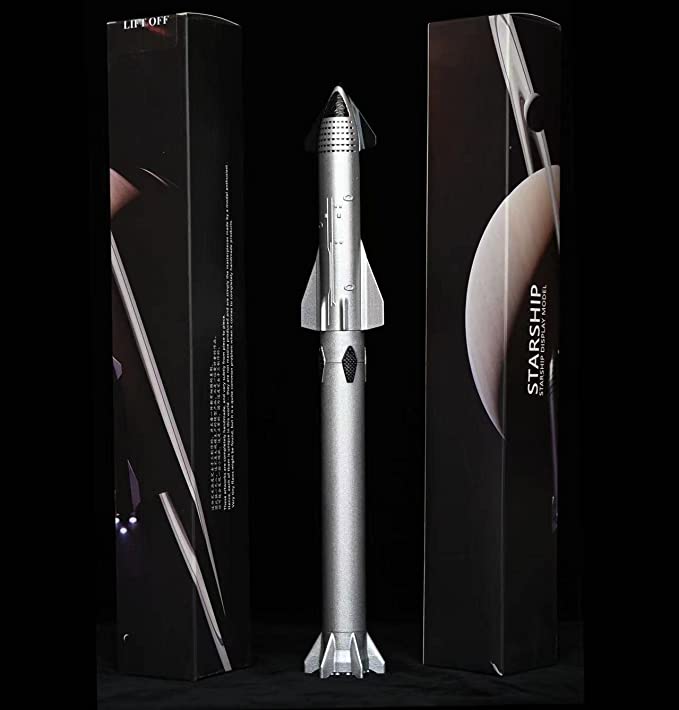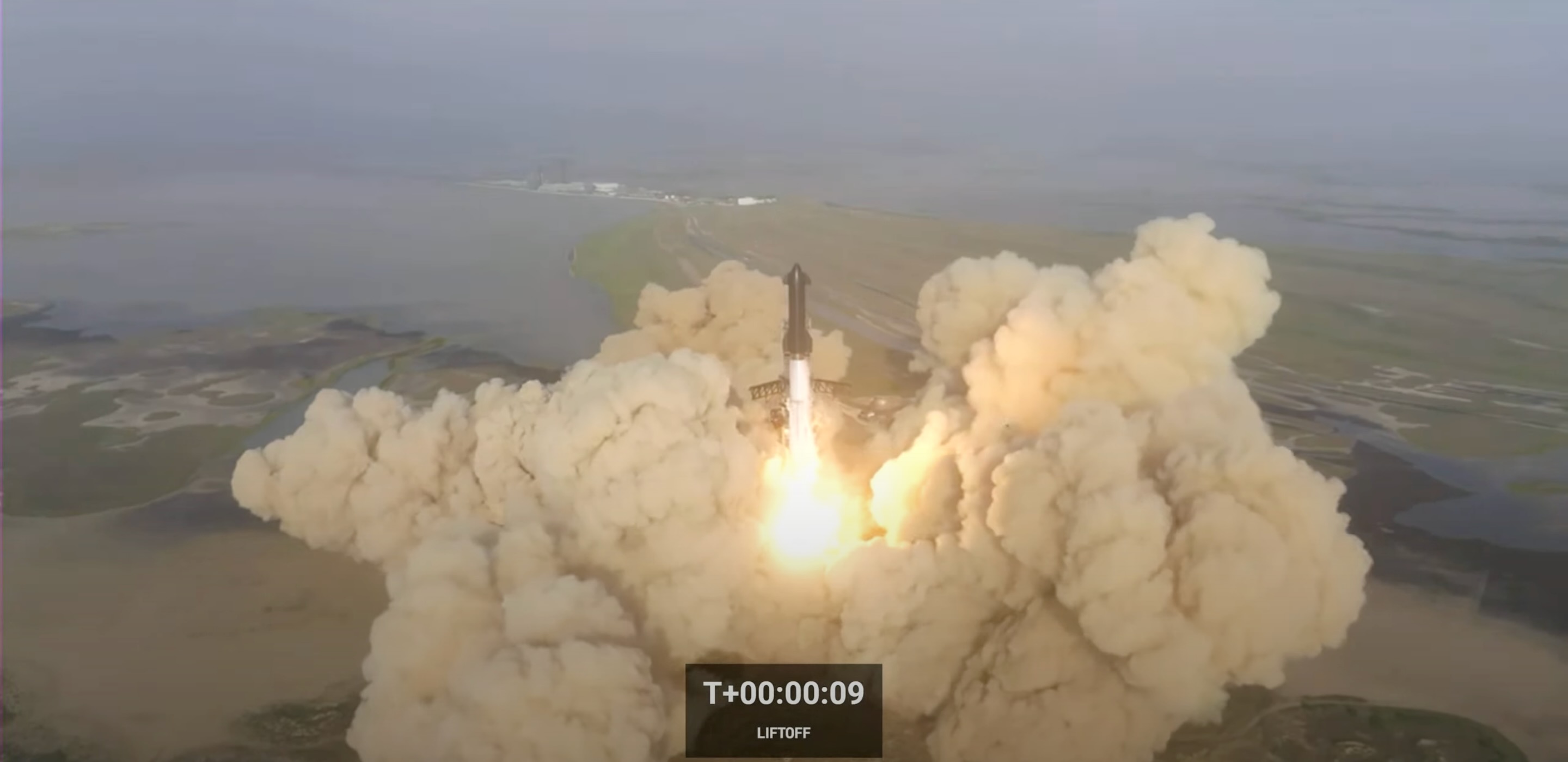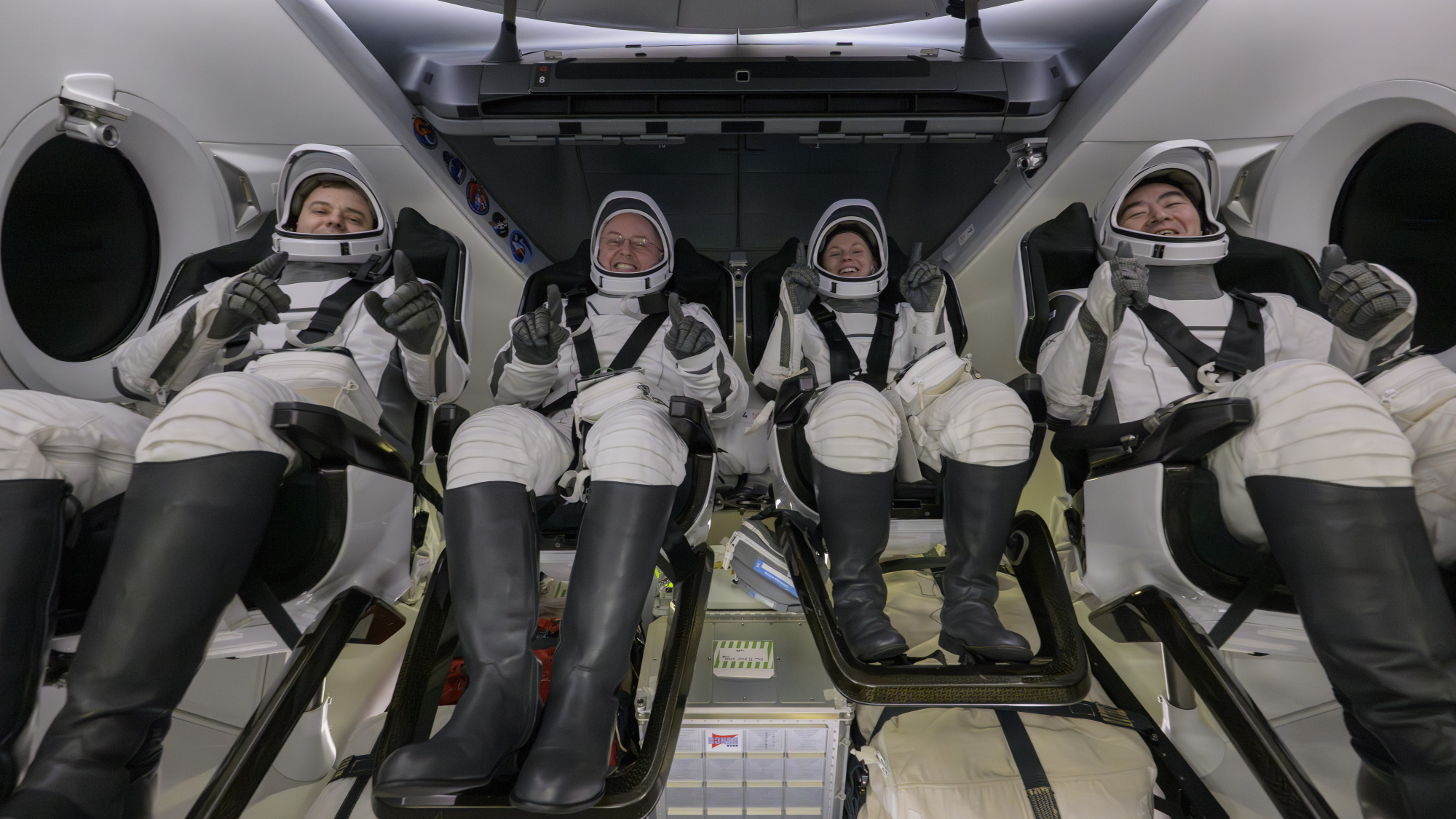SpaceX's 1st Starship launches on epic test flight, explodes in 'rapid unscheduled disassembly'
A fully stacked Starship left the ground today (April 20) for the first time ever — and it came to an explosive end high in the Texas sky.
SOUTH PADRE ISLAND, Texas — The most powerful rocket ever built put on quite a show during its debut space launch.
With a mighty roar, the first-ever integrated Starship rocket soared toward space today (April 20) from SpaceX's seaside Starbase facility at Boca Chica Beach here on South Texas' Gulf Coast at 9:33 a.m. EDT (1333 GMT; 8:33 a.m. local Texas time).
It was a spectacular and surreal sight: The 394-foot-tall (120 meters) Starship, the biggest and most powerful rocket ever built, rose off Starbase's orbital launch mount atop a pillar of flame generated by its 33 first-stage Raptor engines. Starship kept climbing in defiance of its tremendous bulk, its shiny, stainless-steel body reflecting the Texas morning sun all the while.
Related: Here's the plan for SpaceX's 1st Starship space launch
The climb didn't last long, however. The 165-foot-tall (50 m) Starship upper stage was supposed to separate from the Super Heavy first stage about three minutes after liftoff, but that never happened. The two vehicles remained connected, and the stack began to tumble, ultimately exploding — or experiencing a "rapid unscheduled disassembly," as SpaceX terms it — just under four minutes after launch.
This destruction was intentional, ordered after Starship experienced those problems.
"The vehicle experienced multiple engines out during the flight test, lost altitude and began to tumble. The flight termination system was commanded on both the booster and ship," SpaceX wrote in an update a few hours after the flight.
Breaking space news, the latest updates on rocket launches, skywatching events and more!
But the employees gathered at SpaceX headquarters in Hawthorne, California to watch the launch let out a massive cheer at Starship's demise, celebrating the gains made on its first-ever liftoff. The giant vehicle reached a maximum altitude of about 24 miles (39 kilometers), according to the data on SpaceX's launch webcast.
"To get this far is amazing," SpaceX's Kate Tice said during the webcast. "Everything after clearing the tower was icing on the cake."
It was SpaceX's second attempt to launch Starship; an initial try on April 17 ended in a scrub due to a frozen valve.

You can have a Starship of your own with this desktop rocket model. Standing at 12.5 inches (32 cm), this is a 1:375 ratio. See our roundup of awesome Starship gear.
The flight plan today called for Super Heavy to come back to Earth in the Gulf of Mexico roughly eight minutes into the flight. The upper stage, meanwhile, was supposed to fire up its six Raptors to head up to the final frontier, and a planned partial trip around our planet.
The goal was to get Starship to a maximum altitude of about 145 miles (233 km), then bring it barreling back into Earth's atmosphere for a trial-by-fire reentry, ending with a hard splashdown in the Pacific Ocean not far from the Hawaiian island of Kauai about 90 minutes after liftoff.
SpaceX wasn't expecting everything to work out, however; new rockets often fail on their first test flight, and Starship is far bolder and more complex than most launchers. (It has 33 first-stage engines and stands nearly 400 feet tall, after all.) Rather, today was all about gathering data and responding properly to whatever ended up happening, company representatives stressed.
"Now this was a development test. It's a first test flight of Starship. And the goal is to gather the data and as we said, clear the pad and get ready to go again," SpaceX Principal Integration Engineer John Insprucker said during the company's livestream. "So you never know exactly what's going to happen. But as we promised, excitement is guaranteed. And Starship gave us a rather spectacular end to what was truly an incredible test as far."
Congrats @SpaceX team on an exciting test launch of Starship!Learned a lot for next test launch in a few months. pic.twitter.com/gswdFut1dKApril 20, 2023
Vast crowd in awe of Starship
Hundreds of onlookers cheered along the beach here as they watched the giant rocket lift off.
A day earlier, many of them actually got a close look at Starship by driving out to Boca Chica Beach, along an access road that runs alongside the launch pad. There, they stood on sand dunes and marveled at the towering rocket. Some cooked hotdogs on grills in the warm spring evening.
"It's just going to be kind of amazing just to see what happens," Shannon Hulbert, 49, told Space.com while observing Starship on its pad from the dunes of Boca Chica Beach. "I love ... the quest that the SpaceX team has the idea of going to Mars and making us multiplanetary."
Hulbert, the CEO of cloud computing company Opus Interactive, drove to South Texas from Houston to watch the launch. Other spectators came from farther locales —Mississippi and Alabama in the U.S., Toronto in Canada and more — just to glimpse the first-of-its-kind launch.
Chad Whitney, a 51-year-old software engineer from Waveland, Mississippi, drove his family across nearly 740 miles (1,190 km) in their "Rocket Van" to watch Starship launch. He and his 15-year-old son Jack are chronicling the trip with their RocketVan YouTube channel and were joined by Whitney's wife, Amanda, and the Whitneys' daughter, Maggie, 18.
"Jack wants to be an engineer, and what you see behind us is the finest engineering. It just doesn't get better than that," Whitney told Space.com of Starship.
The Whitneys arrived in South Texas before SpaceX's first launch attempt on Monday and watched engineers stack the massive Starship spacecraft atop its Super Heavy booster. The view was awesome, the Whitneys said, and inspiring for kids like Jack who hope to build a better tomorrow.
"I aspire to be an aerospace engineer, you know, and building that thing behind us," Jack said.
The dream: A Mars-colonizing rocket
Elon Musk has long stressed that he founded SpaceX back in 2002 primarily to help humanity colonize Mars. The billionaire entrepreneur believes that Starship is the vehicle that will finally allow us to do that.
SpaceX has been working on the deep-space transportation system for a while now. Musk unveiled the basic architecture back in 2016, calling it the Interplanetary Transport System. A year later, the name had changed to BFR — short for "Big Falcon Rocket," or a NSFW variant on that, depending on whom you asked. BFR then morphed into Starship, the name it has held for a few years now.
Starship consists of a giant first-stage booster called Super Heavy and an upper stage known, somewhat confusingly, as Starship. Both of these vehicles are designed to be fully reusable, which is the key breakthrough that Musk thinks will finally bring the Red Planet within reach. (The two elements of the Starship that launched today — the Booster 7 Super Heavy prototype and the Ship 24 upper stage — were not going to fly again; SpaceX wasn't planning to recover them from the sea.)
And SpaceX's new Raptor engine is powered by liquid methane and liquid oxygen, a combo also chosen with Mars in mind: Both can be produced on the Red Planet, allowing Starship to launch efficiently from Mars as well as Earth.
Musk envisions fleets of Starships flying multiple times per day here on Earth, their Super Heavy boosters coming directly back to the launch mount after each liftoff for rapid inspection, refueling and relaunch. Such extensive reuse could theoretically bring the cost of each Starship mission down to just a few million dollars, Musk has said. That price point would be truly revolutionary, considering Starship's power: It will be capable of lofting 165 tons (150 metric tons) to Earth orbit on each mission in its reusable configuration, according to the Starship specifications page.
To put the vehicle's brawn into perspective: Super Heavy's 33 Raptors generate about 16.7 million pounds of thrust at liftoff. That's nearly twice as much as the previous record holder, NASA's Space Launch System megarocket, which flew for the first time last November on the Artemis 1 moon mission.
Related: Artemis 1 launch success makes NASA's SLS the most powerful rocket ever to fly
A highly anticipated flight
SpaceX had launched a handful of test flights from Starbase before today, but those previous efforts were a different breed. They got nowhere near space, involved only upper-stage spacecraft (without a Super Heavy attached) and featured a maximum of three Raptor engines.
And it had been a while since we'd seen one of these flights; a Starship prototype last launched in May 2021, sticking its landing after soaring about 6 miles (10 km) into the South Texas sky.
Ever since that three-engine success, SpaceX has been gearing up for the next big step in the Starship test program — the first space launch, which would feature an integrated Starship-Super Heavy stack for the first time. And that’s what we saw today. (Some people have described today's mission as an orbital test flight, but that’s not accurate, given that it wasn't designed to send Starship on a full lap around Earth.)
The relatively long leadup to today's test flight wasn't attributable merely to the challenges of technological development; there were regulatory hurdles, too. For example, the U.S. Federal Aviation Administration (FAA) reviewed SpaceX's application for a Starship near-orbital launch license for more than 500 days before finally granting it on Friday (April 14).
As part of this process, the FAA conducted an in-depth environmental review of activities at Starbase, instructing SpaceX to perform more than 75 mitigating actions to minimize the impact on the surrounding ecosystem, which is incredibly biodiverse.
Many more Starship launches to come
We should expect SpaceX to fly Starship again relatively soon, provided the U.S Federal Aviation Administration (FAA) clears the company to do so. The FAA is currently investigating what happened on the vehicle's debut launch.
"A return to flight of the Starship/Super Heavy vehicle is based on the FAA determining that any system, process or procedure related to the mishap does not affect public safety," FAA officials wrote in an update shortly after the mission. "This is standard practice for all mishap investigations."
The company has multiple Starship vehicles in production at Starbase, and the plan is to fly them pretty much as soon as they're ready. That's in keeping with Musk's philosophy, which prioritizes the advances gained from flight tests, even (or perhaps especially) those that fail.
If the test campaign goes well, people could climb aboard Starship for the first time just a few short years from now. NASA selected Starship to be the first crewed lander for its Artemis moon program, for example. The SpaceX vehicle will put astronauts down near the lunar south pole on the Artemis 3 mission, which is targeted to launch in 2025 or thereabouts.
SpaceX has already sold two private around-the-moon Starship missions as well. One was booked by Japanese billionaire Yusaku Maezawa, who will fly with a crew of eight artists and influencers. Dennis Tito, who paid his own way to the International Space Station back in 2001, will fly on the other Starship moon mission along with his wife, Akiko, and other passengers whose identities have not yet been disclosed.
Target launch dates for those two private moon missions have not yet been announced. But they, and all of Starship's other envisioned future flights, are a little closer to reality now that the huge vehicle has actually gotten off the ground.
Editor's note: This story was updated at 3:15 p.m. EDT on April 20 to note that SpaceX ordered the destruction of Starship via the vehicle's flight termination system. It was updated again at 3:45 p.m. EDT on April 26 to include the FAA statement about its ongoing investigation.
Mike Wall is the author of "Out There" (Grand Central Publishing, 2018; illustrated by Karl Tate), a book about the search for alien life. Tariq Malik is the Editor-in-Chief of Space.com. Follow them on Twitter @michaeldwall and @tariqjmalik. Follow us on Twitter @Spacedotcom or Facebook.

Michael Wall is a Senior Space Writer with Space.com and joined the team in 2010. He primarily covers exoplanets, spaceflight and military space, but has been known to dabble in the space art beat. His book about the search for alien life, "Out There," was published on Nov. 13, 2018. Before becoming a science writer, Michael worked as a herpetologist and wildlife biologist. He has a Ph.D. in evolutionary biology from the University of Sydney, Australia, a bachelor's degree from the University of Arizona, and a graduate certificate in science writing from the University of California, Santa Cruz. To find out what his latest project is, you can follow Michael on Twitter.


